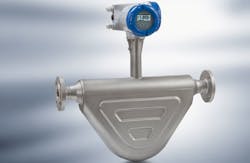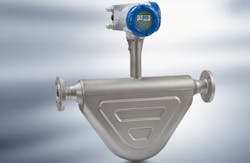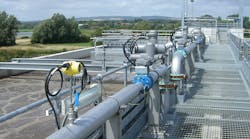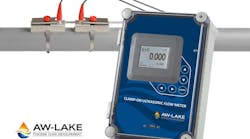Krohne also says its bent-tube Coriolis flowmeter embodies design innovations, including completely digital signal processing, for outstanding dynamic density measurement and enhanced diagnostic and status indications. Krohne is a supplier of industrial process instrumentation with U.S. headquarters in Peabody, Mass.
"This is an all-new twin bent-tube Coriolis mass flowmeter for standard liquid and gas applications in the process industries," says Joe Incontri, Krohne marketing director, Americas. "But it also has unique capabilities."
As is well known, gas entrainment refers to the presence of gas bubbles in a process stream. Entrained gas can disturb mass-flow liquids measurement, cutting accuracy or even stopping measurement completely.
Coriolis mass flowmeter technology can achieve stable, uninterrupted liquids measurement, even with high gas content, Incontri says. "Typically, Coriolis flowmeters struggle when use includes rapid changes in density in the liquid flow."
With other mass flowmeters, Incontri says, relative movement between gas and fluid dampens the amplitude of the measuring tube and interferes with the electronics’ capability to determine the actual resonant frequency. In contrast, the Optimass 6400 can follow and correct for the varying amplitudes. In addition, the signal converter’s advanced device and process diagnostics are compliant to NAMUR NE 107.
"Entrained gas management, as a feature of this flowmeter, allows presentation of an actual measured reading at all times," says Incontri, "including indication or alarm that identifies transient gas entrainments."
Gas bubbles
While most commonly associated in the general public’s mind with upstream oil and gas production, gas bubbles can be found in many applications in the chemical, food & beverage and pharmaceutical industries.
Gas bubbles can form, for example, due to degassing; leaks upstream of or in a negative pressure area; excessive cavitation; supply container levels falling below minimums; tank agitation; long drop distances for media into tanks; and process-control status transitions, such as system start-up, shut-down or cleaning.
In other cases, gas bubbles are deliberately introduced as part of a production process. In such cases, gas flow is often measured upstream of a sprayer used to introduce bubbles.
Coriolis flowmeters are the most accurate made, says Dr. Jesse Yoder, principal with Flow Research, "Large line-size [Coriolis] meters may begin to penetrate the market for measuring petroleum liquids. Coriolis meters are already displacing positive displacement meters for liquid petroleum applications involving downstream delivery. It remains to be seen, however, how widely they will be used for upstream oil-field or custody-transfer applications."
Krohne’s Optimass 6400 is not a multiphase meter, says Incontri, "but it is a meter that can operate in environments in which there are multiple phases."
Gas entrainment challenges
The consequences of gas entrainment should not be underestimated, because it affects process control measurements and thus results in unreliable product quality. Because of this, NAMUR recommendation NE 107, "Self-monitoring and Diagnosis of Field Devices," for "smart" flow-measurement processes, classifies the presence of entrained gas as an error condition in Category 1, the highest possible.
On the other hand, some in the industry caution against making gas entrainment a bigger problem than necessary and that it actually occurs in significantly fewer processes than measurement devices might suggest.
"Gas bubbles in chemical processes are one of the most frequent reasons that system operators call service employees to test a supposedly faulty device," says Frank Grunert, Krohne’s global product group manager for Coriolis mass flowmeters. "The user is often astonished to find that the meter is measuring according to specification and the unexpected gas content can be discovered based on review of the recorded density changes or meter diagnostic values."
From the point of view of anyone wishing to measure flow, gas entrainment involves a liquid-gas flow. Multiple measured values are required to characterize a two-phase flow, including percentage volume of the dispersed phase in the continuous phase, densities of both phases, morphology (i.e., size, shape and distribution) of the dispersed phase that occurs, continuous-phase viscosity, operating pressure and surface tension of the continuous phase.
Liquid-gas flows have very different type characteristics than other type flows, and Incontri says that no single measuring principle covers all parameters of concern. Combining several measuring principles into a single system leads to a better flow description, but the technical effort and expense involved is high.
Reliably signaling gas entrainment
The Coriolis mass flow principle for flow measurement is well suited for detecting gas entrainment because it precisely recognizes mass and density changes in the measurement substance.
However, until recently, "gas entrainments posed a great challenge for Coriolis mass flowmeters. The relative movement of the different phases damps the vibration of the measuring tube, and this damping leads to widely varying vibration frequencies of the measuring tube. These inconsistent frequencies then interfere with most meter electronics’ ability to track the actual fluid flow in the measured tube," says Incontri.
In addition, the damping effect caused by the gas content in the liquid in the electro-mechanical driver system of the Coriolis mass flowmeter can be larger than the driver input power. If the vibration of the measuring tube cannot be maintained, the result can be interruption in measurement.
Krohne says the Optimass 6400 can detect and signal gas entrainment reliably and maintains active measurement in all measuring conditions, with gas content from zero to 100% by volume.
The device is "gas-bubble resistant," says Incontri. In other words, the measuring sensor and signal converter offer complete digital signal processing, from the production of the drive oscillation of the measuring tube to the evaluation of the sensor signals. In this way, it is possible to reliably detect process changes and indicate actual production-line conditions.
Digital signal processing has been incorporated into Coriolis mass flowmeters for many years, Incontri explains, but was used only for sensor-signal evaluation. An analog signal circuit used for drive vibration amplifies the measured resonant frequency of the measuring tube and returns it to the measuring tube as an impulse signal.
When gas bubbles are present, the vibration signal is disturbed due to the transients in the damping and density of the medium. With the analog drive system disturbance recorded and amplified, the impulse signal is disturbed as well. This means a loss in output because the excitation only occurs in the resonance of the measuring tube, which is not efficient, and also leads to a fault in the frequency measurement. Both end up increasing deterioration of the tube-oscillation measurement and, as a result, the mass flow measurement. Control of the driver system can also be lost, requiring restart of the meter before measurement can be restored. This restart happens automatically in most meters. However, the meter is effectively offline during this period.
The fix found
Because the Optimass 6400 has synthetic driver oscillation and high-resolution digital-signal processing, Krohne says, the oscillation is produced using a digitally generated and therefore known impulse frequency. Measuring-tube oscillation occurs due to this impulse, so the frequency of the measuring tube is known precisely. This correlation doesn’t change, even with gas-bubble disturbance. The control loop remains "clean" and is not disturbed by interspersed and amplified frequencies.
In this way, "the meter accurately measures amplitudes and phases, even in disturbed conditions, and regulates them in the resonance," says Incontri. "The device remains in operation, even if there is gas content or air pockets anywhere from zero to 100% by volume in the medium."
Different indicators for gas bubbles are set in the signal converter. Based on known cross-sensitivities, two or more indicators are combined for a reliable diagnosis. According to NAMUR NE 107, the most important requirement is that the results of the diagnosis be reliable, so that users take correct actions.
For many users, a crucial criterion for selecting a measuring device is the accuracy with which it measures the occurrence of gas bubbles. Best practice procedures demonstrate that gas bubbles cause process changes. This can lead to inaccurate flow measurement. In addition, gas bubbles can vary widely in size and frequency of occurrence, and temperature, pressure or viscosity changes need to be considered. Users need to be cautious regarding the accuracy of available measurements in indicating the occurrence of gas bubbles and changing process conditions.
Available in a range of tube diameters from 3/8 inch to 10 inch, the Optimass 6400 is offered in stainless steel 316L, Hastelloy C22 and Duplex steel UNS S31803. Compliant to NAMUR standard installation lengths, it operates in high temperatures up to 752 F, as well as cryogenic applications down to -328 F. It also handles pressures nearing 3000 psi (200 bar).



